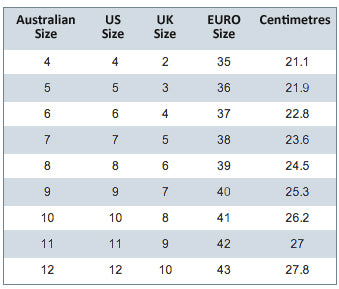Understanding US to AUS Size Conversions for Kids: A Parent’s Guide
Hey there, amazing parents and guardians! Are you scratching your head trying to figure out the perfect size for your kiddo’s new clothes? Fret no more! Whether you’re browsing online shops from Down Under or planning a shopping spree while visiting the States, we’ve got you covered. Our cheerful guide will help you navigate the sometimes confusing world of US to AUS size conversions for children’s clothing. Say goodbye to guessing games and hello to outfits that fit just right!
Why Size Conversion Matters
It’s no secret that kids grow like weeds, and keeping up with their clothing sizes can be a real challenge. When you add international sizing into the mix, the task can become even more daunting. But don’t worry—understanding size conversion is your secret weapon in ensuring your child looks and feels great in their new threads.
Converting US Sizes to AUS Sizes: The Basics
Before we jump into the nitty-gritty, let’s lay the groundwork with some basic knowledge. Generally speaking, US and Australian sizes are fairly similar, but there are some key differences you’ll want to know about to ensure you’re making the most informed choices possible.
General Size Conversion Chart
To kick things off, here’s a handy chart that gives you a general idea of how US sizes match up to AUS sizes:
- US Size 2T = AUS Size 2
- US Size 3T = AUS Size 3
- US Size 4T = AUS Size 4
- US Size 5 = AUS Size 5
- US Size 6 = AUS Size 6
- …and so on!
Keep in mind, however, that these are approximations and sizes can vary between brands. It’s always best to check specific brand size charts for the most accurate fit.
Delving Deeper: Age, Height, Weight, and More
When you’re comparing sizes internationally, you’ll need to consider more than just the number on the tag. Children’s sizing can also factor in age, height, and weight. Simple charts are a good starting point, but knowing your child’s measurements can really fine-tune the fit of clothing.
For instance, a US Size 4T might be intended for a child approximately 39-41 inches in height and weighing around 34-38 pounds. The Australian equivalent size would be similar, but you may notice that Australian sizes can sometimes allow for a more generous fit, accommodating a slightly taller or heavier child.
In our comprehensive guide, we’ll delve into detailed size charts that consider all these variables, ensuring that you’ll find the best fit for your child whether you’re shopping for everyday wear, special occasions, or sports gear.
Stay tuned as we guide you through an array of considerations, from seasonality and style to tips for shopping online or abroad. Get ready to become the expert on US to AUS size conversions, and rest easy knowing your little one’s clothes will fit as wonderfully as they look!
We’re just getting started on our sizing journey, and there’s plenty more to come. Keep reading for in-depth charts, brand-specific insights, and real-life tips for making size conversion a breeze. No more returns, no more guesswork—just happy kids in perfectly fitting outfits. Shall we continue on this fashion-forward quest together? Absolutely!

5 Essential Tips for Parents Preparing for US to AUS Size Conversions
Embarking on the exciting venture of converting US sizes to AUS for your children can seem overwhelming at first, but with these top tips, you’ll be shopping like a pro in no time!
Tip #1: Always Measure Your Child Before Shopping
To ensure the best fit, it’s essential to have up-to-date measurements of your child. This includes their height, chest, waist, and hip measurements. Keep a note of these measurements on your phone or in a handy place for quick reference while shopping.
Tip #2: Understand the Brands’ Sizing Policies
Every brand can have its unique fit, so it’s important to look up the brand’s specific size chart for both US and AUS measurements. Pay close attention to any size recommendations or notes regarding the fit of their clothing.
Tip #3: Read Reviews and Check for Size Feedback
Other parents are your best resource when it comes to sizing. Read reviews to see if other customers found the sizes ran big, small, or true-to-size. This can save you the hassle of returns or exchanges.
Tip #4: When in Doubt Size Up
Children grow quickly, and it’s better for clothes to be a bit roomy than too tight. If you’re caught between two sizes, opt for the larger one to ensure a longer period of wear.
Tip #5: Utilize Online Size Conversion Tools
Several online tools can help simplify the conversion process. Find a reliable size conversion calculator that allows you to input your child’s measurements for instant size recommendations.
With these savvy shopping tips up your sleeve, you’re well on your way to ensuring each shopping trip—be it virtual or physical—is a successful one for you and your youngsters!
How to Account for Seasonality in Clothing Sizes
Don’t forget to consider the changing seasons in both the US and Australia when shopping. You might need to adjust the clothing size to accommodate layering during colder months or opt for a snugger fit in the summer when heavy layering isn’t needed.
Wrapping It All Up: Next Steps in Converting Sizes
By now, you’ve armed yourself with the know-how to tackle US to AUS size conversions with finesse. Keep these charts and tips handy, and shopping for children’s clothing across the globe will be as easy as pie—or should we say, as delightful as a lamington!
Gearing up to fill your cart with fashionable picks for your little ones? Remember to measure, compare, and read up on those invaluable brand-specific sizing guidelines. It’s all about embracing the excitement of finding awesome outfits for your kiddos and loving every step of the shopping journey.
And there you have it, dear parents and guardians. You’re now equipped with all the facts, figures, and friendly advice needed to master the art of international size conversions! No more puzzling over tags—just sheer joy as you watch your child twirl, jump, and strut in perfectly fitting attire, no matter where it’s from. Now, let’s get shopping!
For more great articles please see here. For more information see here
Disclaimer
The articles available via our website provide general information only and we strongly urge readers to exercise caution and conduct their own thorough research and fact-checking. The information presented should not be taken as absolute truth, and, to the maximum extent permitted by law, we will not be held liable for any inaccuracies or errors in the content. It is essential for individuals to independently verify and validate the information before making any decisions or taking any actions based on the articles.




